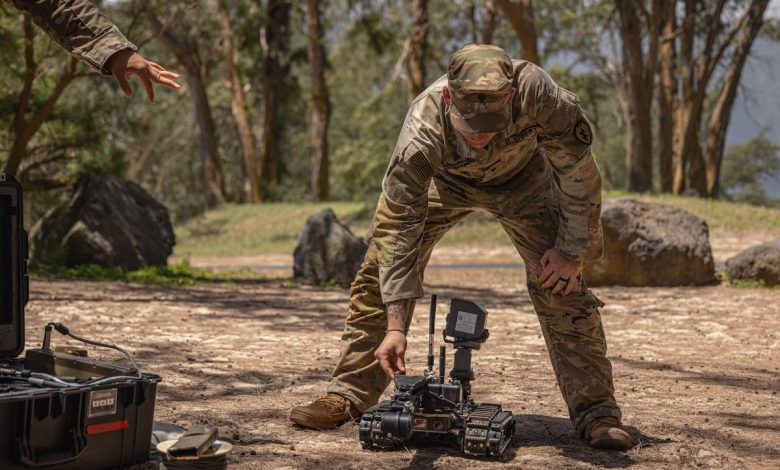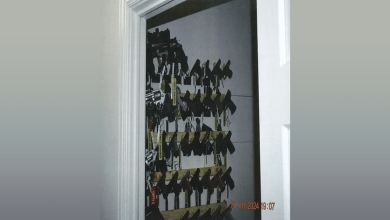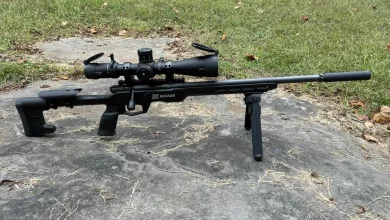From drone swarms to exoskeletons, Army charts path for robotic future

As the Army updates how it uses robots and autonomous systems in the next fiscal year, drone swarms, automated convoy operations and an exoskeleton to lighten the load are on the horizon.
The Army released its Robotics and Autonomous Systems, or RAS, strategy in 2017 with a series of near-, mid- and long-term priorities.
Since the release, the service has met its early goals, which included lightening the load for dismounted soldiers, automating some parts of ground resupply and adding more robots in dangerous jobs such as explosive ordnance disposal.
Stuart Hatfield, a division chief at the Army headquarters soldier resourcing programs, shared current and future projects for the robot-soldier future, spanning from now through 2030.
RELATED
“The RAS strategy priorities I don’t think are going to change even as we update our strategy,” Hatfield said at the September National Defense Industrial Association’s annual Future Force Capabilities Conference.
New projects, Hatfield said, include Tethered-Unmanned Aircraft Systems; medium-sized Joint Tactical Autonomous Aerial Resupply System; the Common Robotic System Medium variant; the Dismounted Unit Soldier Transport, or DUST; a first-person-view drone option and an exoskeleton for dismounted soldiers.
While he didn’t share timelines on specific systems, some of the capabilities are expected to arrive in the coming years.
Funding for these programs has increased steadily over the past decade. The Army got its first $7 million from Congress for robot strategy work in fiscal 2015; that grew to $335 million in the fiscal 2021 budget. For fiscal 2025, the current request is for $480 million, according to budget documents.
A version of the DUST device was in use during the recent rotation of the 2nd Brigade, 101st Airborne Division at the Joint Readiness Training Center at Fort Johnson, Louisiana, in August.
During the rotation, soldiers used a kind of motor-assisted wheelbarrow device previously called the Silent Tactical Energy Enhanced Dismount, or STEED, to move gear and role-playing “wounded” soldiers.
It’s a simpler device than some of the more complex technology that the Army is testing in other areas, but it does take a load off the soldier. The STEED can travel 15 to 30 miles on a single battery pack and carry up to 500 pounds, according to manufacturer Hendrick Motorsports.
The Common Robotic System Medium variant — currently under development — is a larger version of the individual model. The individual variant, which has been fielded to some Army units, is a 32-pound tracked robot with multiple cameras and an extendable arm that can fit into a rucksack.
The medium version would be capable of carrying more equipment and a variety of payloads that could include sensing devices or weapons platforms.
As far as robot-driven vehicle convoys, Army Times reported work back in 2021 that had already seen soldiers running 2,000 unmanned miles. The convoys were not entirely “robotic” but instead featured a single, manned vehicle and nine “follower” vehicles.
“We’ve got the robotic applique, which takes robotic technology and applies it to currently manned systems and makes them optionally [manned],” Hatfield said.
The focus in 2021 was to use medium-sized trucks with pallet loads, a typical resupply that soldiers might have experienced during the wars in Iraq and Afghanistan.
Those convoys were often the target of attacks by insurgents and terrorists. The Army and other services are working on a variety of resupply methods, including drones.
But ground vehicles will continue to fit into the work as those platforms can carry more cargo than other options for land-based forces.
A full combat “Iron Man”-style suit has been in some sort of development for decades now. The Tactical Assault Light Operator Suit, or TALOS, was proposed by U.S. Special Operations Command officials in 2013.
But in subsequent efforts, the Pentagon decided to pursue parts of the total-body system instead of a do-it-all suit.
That’s resulted in some simplified attachments that take the strain off heavy loads by supporting a soldier’s hips, lower back and legs.
Todd South has written about crime, courts, government and the military for multiple publications since 2004 and was named a 2014 Pulitzer finalist for a co-written project on witness intimidation. Todd is a Marine veteran of the Iraq War.
Read the full article here






